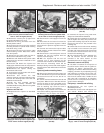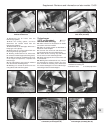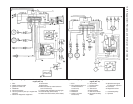
Fault finding - turbocharger system
Supplement: Revisions and information on later models 13•85
13
Noise or vibration
ⅥⅥ Worn shaft bearings
ⅥⅥ Lack of lubrication
ⅥⅥ Inlet or exhaust manifold leaking
ⅥⅥ Out-of-balance impeller shaft
Engine “pinking”
ⅥⅥ High boost pressure, caused by faulty wastegate valve
ⅥⅥ Fuel octane rating too low
ⅥⅥ Faulty TDC sensor (ignition advanced)
ⅥⅥ Incorrect spark plugs or plug gaps, or spark plugs worn
Indicated boost pressure too high
ⅥⅥ Faulty wastegate valve
ⅥⅥ Ice forming in exhaust pipe (during very cold weather)
Power loss/indicated boost pressure too low
ⅥⅥ Turbocharger leaking, or leak at turbocharger mounting
ⅥⅥ Incorrectly adjusted wastegate valve/wastegate valve not closing
ⅥⅥ Blocked exhaust pipe
ⅥⅥ Clogged air cleaner element
ⅥⅥ Faulty TDC sensor (ignition retarded)
ⅥⅥ Turbo/intercooler connecting hose leaking
Oil leaks from shaft oil seals, with blue exhaust
fumes
ⅥⅥ Oil return pipe blocked
ⅥⅥ Air cleaner element clogged
ⅥⅥ Worn oil seals
10 Ignition system
General
1 The ignition systems dealt with in this
Section are all fully electronic and are referred
to individually according to type as the
“breakerless”, Microplex and Digiplex 2
system. The Microplex system is used on the
1301 and 1372 cc Turbo ie engines, the
Digiplex 2 on the 1372 cc ie engine and the
“breakerless” system on all other models.
Ignition timing
(all later models) #
2 The ignition timing check on all systems
covered in this Section is made using a
stroboscope, connected up in accordance with
the manufacturer’s instructions and pointed at
one of the two positions given below (photos).
a) The timing marks on the crankshaft pulley
and the timing cover. The right-hand
underwing shield will need to be
detached and removed to allow access to
view these marks (see photos 7B.27 and
7B.30B in this Chapter).
b) The timing marks on the flywheel and the
clutch housing. The rubber plug will need
to be extracted for access to these marks.
3 A dwell angle check is not possible on any
of these systems.
4 When making the stroboscopic ignition
timing check it is necessary to disconnect the
vacuum hose from the distributor or inlet
manifold to module (as applicable) and plug it.
The engine must be at its normal operating
temperature and running at the normal
specified idle speed when making the check.
Refer to the appropriate part of the Specifica-
tions at the start of this Chapter for the idle
speed and ignition settings.
Breakerless ignition system -
description
5 On 903 cc engines, the distributor is driven
from an extension of the oil pump driveshaft
which is geared to the camshaft.
10.2B Flywheel timing marks
(1372 cc ie engine)
10.2A Flywheel timing marks
(999 cc engine)
Fig. 13.70 Breakerless ignition system - 999 and 1108 cc engines (Sec 10)
1 Battery
2 Ignition switch
3 Ignition coil
4 Coil HT lead
5 Distributor
6 ECU
7 LT cables
8 Vacuum advance unit
9 Spark plug HT leads
10 Spark plugs
11 Vacuum hose


















